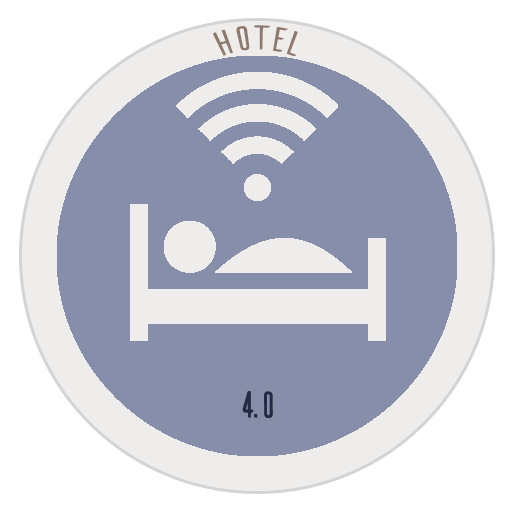One of the particularities of the Class One systems is that we were financial before we were hoteliers, so any event that involves an economic item will always have a reflection of its corresponding accounting entry.
All the movements generated in the different applications are sent to the section of Drafts (of movements, of VAT)
We will now explain in those points of the programme that are related to Accounting.
Configuration Data
B.7. General Configuration. General
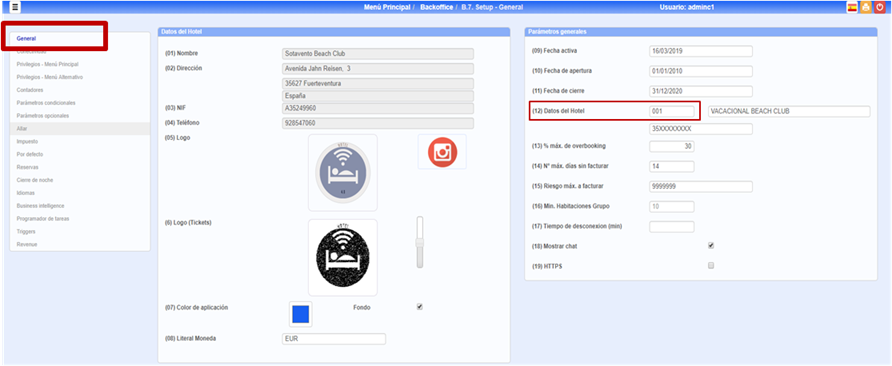
Hotel Code. Hotel Analytical Code, corresponds to the Hotel Cost Centre for analytical studies (XYZ system).
The “2” two last characters are taken.
B.7. General Configuration. Connectivity
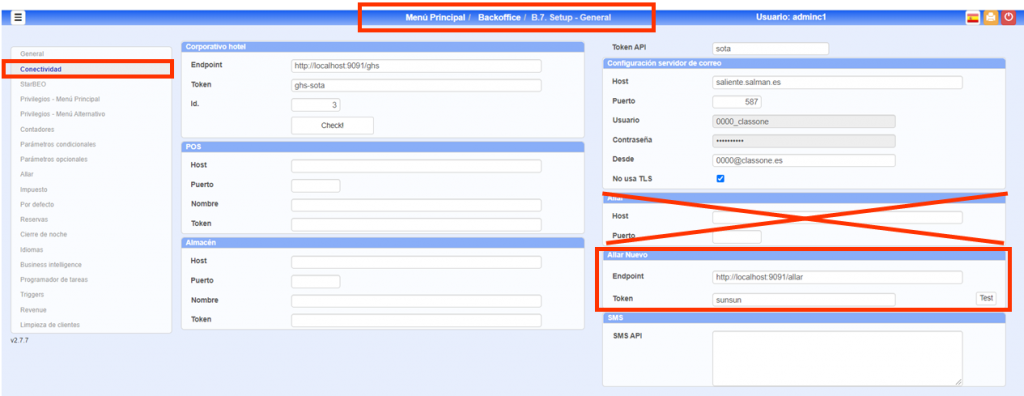
Connectivity. It must be correctly configured according to the location of the accounting program and its tokenization.
B.7. General Configuration. Optional Parameters
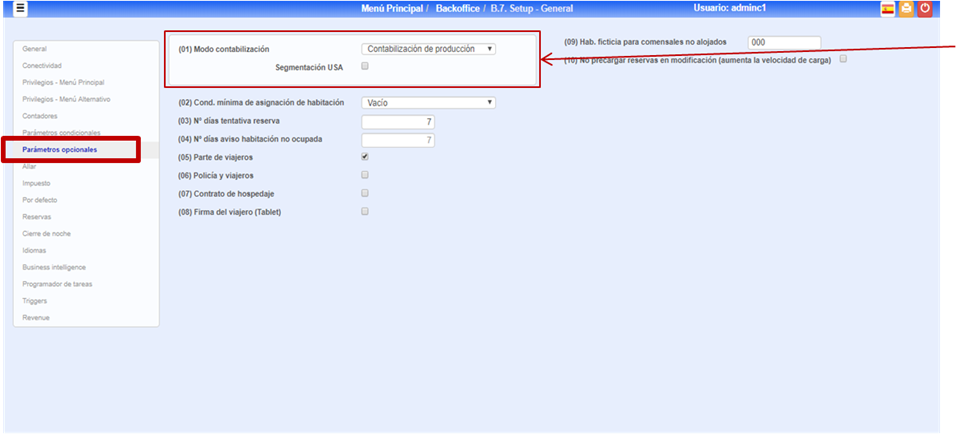
Accounting Mode. There are essentially two different ways of accounting for the hotel.
- Accounting by Production. Every day, Produced pending to be invoiced (group 4) is charged against Sales and when an invoice is made, it is downloaded from Pending to be invoiced against Customer and VAT.
If the USA Segmentation bullet (USALI) is marked, what it does is that sales instead of being made by the accounting accounts that appear in Rooms, it does it by those that appear in Market Segments
- Accounting by invoicing. Every time an invoice is made, the typical Invoicing movement is generated: Customer against Sales and VAT
B.7. General Configuration. Allar

Dimensional Units.
Allar is not just another accounting management programme, it includes the possibility of including the different dimensional units of the Hotel in several generators (Rooms, Sleepers, Accommodation Only Guests, with Breakfast, Half Board, Full Board and All included)
You get reports of this type, for example, in which we can see values such as GOPPAR
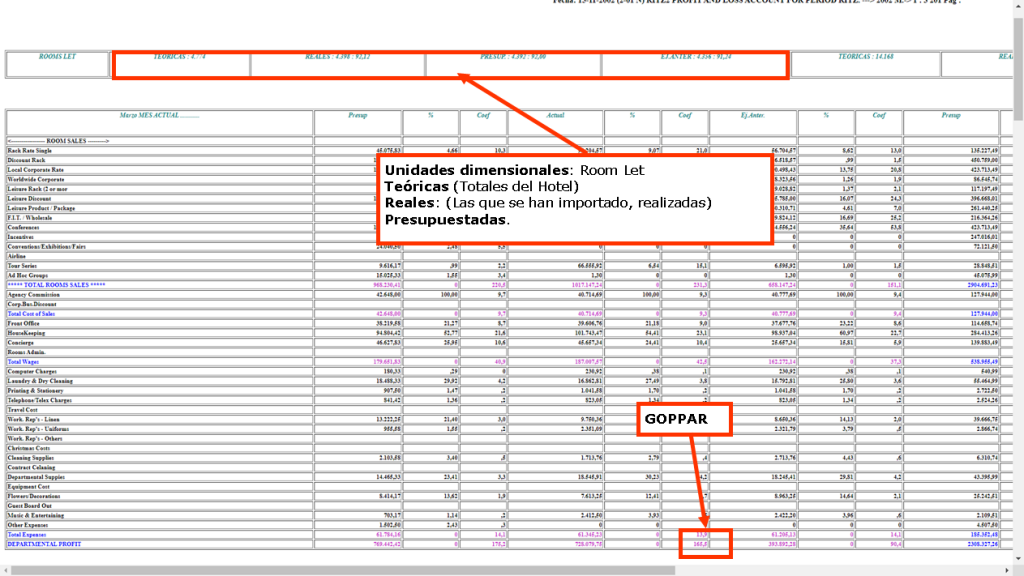
B.7. General Configuration. Tax
The presence of this table facilitates the immediate adaptation of the system to legal changes on taxes without having to interact elsewhere.
Let’s see that there are up to three percentages, it is evident that in hotels in Spain it has no purpose, however it is necessary for other countries, such as the USA, Canada, Brazil, …, as the first percentage is the one applied to the State (Inter-City) and the second is the one applied to the whole national territory. There is even a country that needs three, as is the case of the Dominican Republic.
The possibility that in the future there will be a tax for the European Economic Community, another for the corresponding Autonomous Community and a third for the Spanish State has not been ruled out.
In literal terms, for example in the case of the Canary Islands, IGIC will be applied
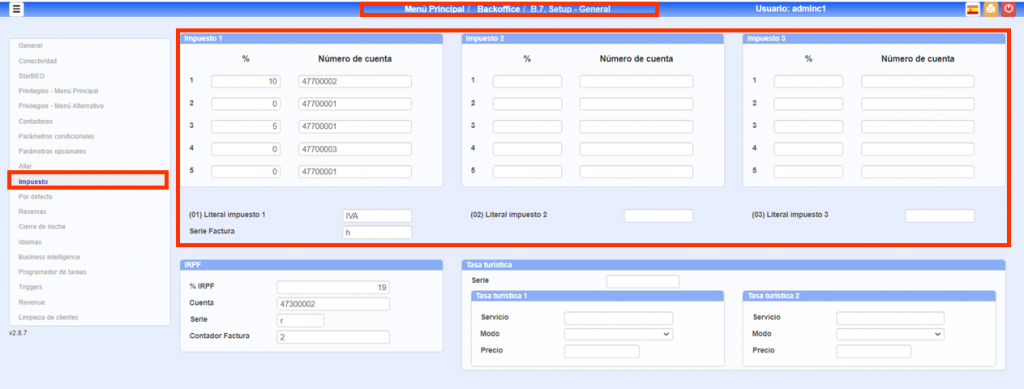
We will define the taxes VAT, IGI, IGIC, TBA, VAT, ISS, GST, tax, with your name, we have the possibility to enable up to 3 different taxes (if you use the second and third, previously must be enabled by Class One)
The normal way is to use Tax 1. where we have the possibility of up to 5 different rates.
Normally rate 5 is set to zero for those services whose tax is zero (SUPLIDED), and is necessary to correctly generate the tax notes, as well as their accounting
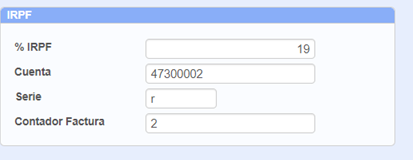
IRPF. There are a series of special invoices in some hotels for the rental of premises. These invoices require this information:
- % of IRPF,
- the IRPF tax account with which it is associated,
- the series for these invoices
- and a numbering counter for them
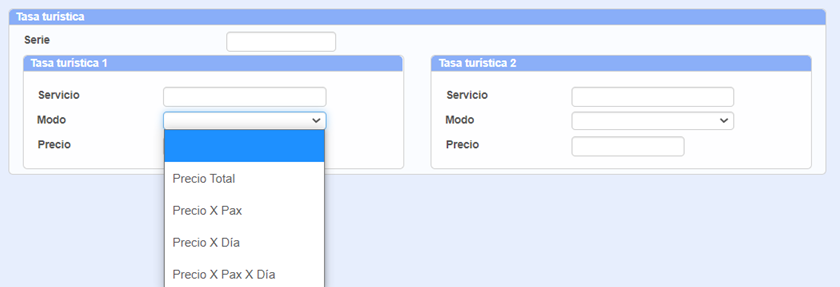
Tourist tax, Ecological tax, City tax. It can be double (City Tax and Country Tax)
- Service with which this tax is associated (must be created in the Service Master .A.6.),
- Mode (those listed),
- Amount
B.7. General Configuration. Task Scheduler
In this tab we can define the different programmings that the program wants us to do, for example, to make a backup at a certain time and day, to make the night closing automatic, to export the data to accounting, etc., and as far as we are concerned, Accounting, which automatically generates the accounting movements and deposits them in the Draft Accounting section
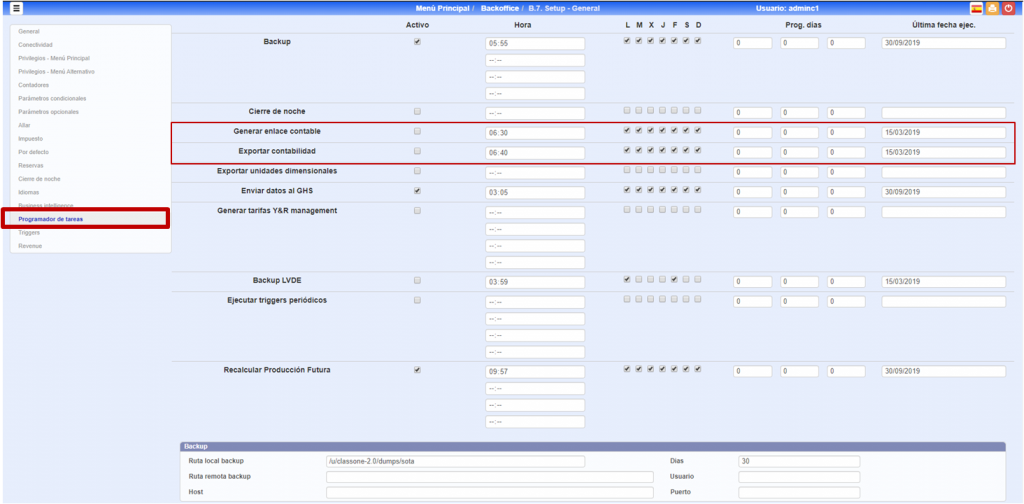
Day Production entries
There are three TOTALLY DIFFERENT FORMS of ACCOUNTING the PRODUCTION together with the INVOICING.
BOTH are determined according to the value we have in section: B.7.6. .02. (ACCOUNTING MODE).
1). PRODUCTION ACCOUNTING.
The criteria APPLIED to the HOTEL OPERATION is: what is PRODUCED goes DIRECTLY to SALES (GROUP .7.) and the INVOICING does not account for GROUP .7.
This ENTRY is GENERATED when the NIGHT CLOSING is made, as long as section .B.7.2. (.17.) contains a different value of SPACES.
2). PRODUCTION ACCOUNTING by MARKET SEGMENTATIONS. The accounting of the invoicing of the ROOMS, instead of being carried out by TYPE of ROOM “NATURE”, is done by the person who occupies it, that is to say, to the account corresponding to the MARKET SEGMENT of the person who is occupying it. (option .A.8.)
1. Production accounting by day
This SEAT is GENERATED when the NIGHT CLOSING is made, as long as the Accounting form is by PRODUCTION. (B.7.)
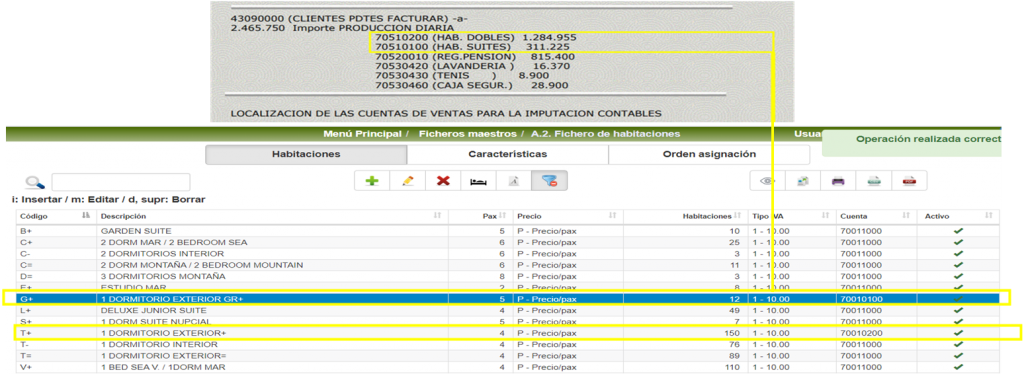
WARNING:
In order to make any verification it is ENOUGH to check that the ACCOUNTING DATA coincide EXACTLY with the PRODUCTION DIARY of the CORRESPONDING DAY associated by ACCOUNTING concepts as defined in the ACCOUNTS.
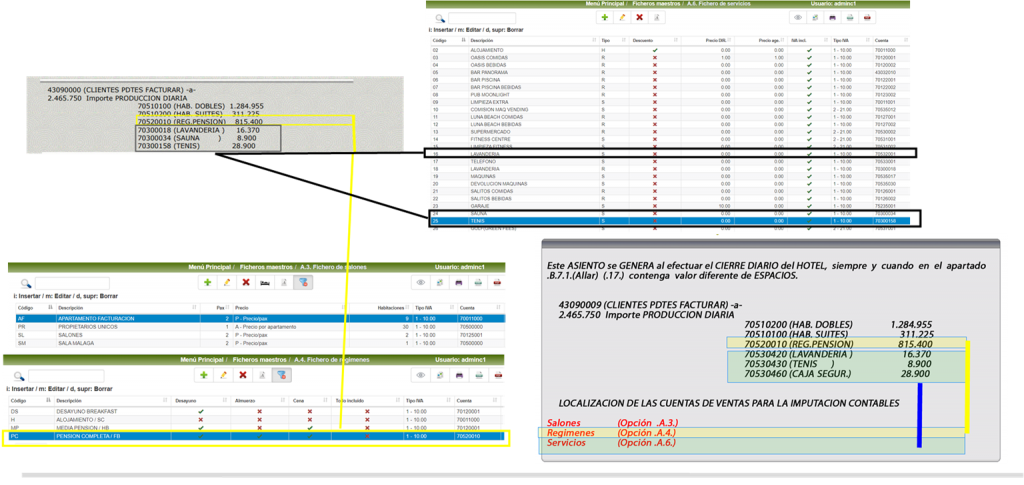
2.Production Day Entry.
Production Accounting by Market Segments
Best method to obtain USALI
Uniform System of Account for Lodging Industry
It is the same as the previous case but the movements of ROOMS are replaced by those corresponding to the ACCOUNTS of the MARKET SEGMENTS that OCCUPY them. The corresponding swicth must be enabled. Option B.7.6.2.= 1/S The MARKET SEGMENT ACCOUNTS MUST BE DONE IN: Option A.8.
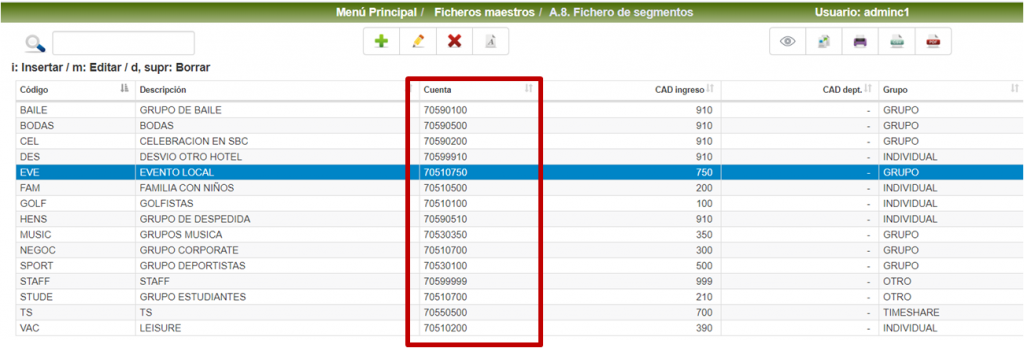
Invoices Entry
This ENTRY is GENERATED every time we make an INVOICE. Let’s first analyze a SIMPLE INVOICE from a BILL that only STAYS in the HOTEL.
Then the screen/s of WHERE THE ACCOUNTS ARE OBTAINED to generate these ENTRIES:
1). CUSTOMER/AGENCY/ENTERPRISE ACCOUNT
If the CUSTOMER, the COMPANY or the AGENCY, the ACCOUNTS are in SPACES, it assumes by default the values found in the Control Register. (.B.7. fields 5, 6, and 7), it is clear that FIXED CUSTOMERS, COMPANIES and/or AGENCIES will normally have an ACCOUNTING code given under ADMINISTRATION criteria.

and the options: (.A.A., .A.B., y .A.C.)
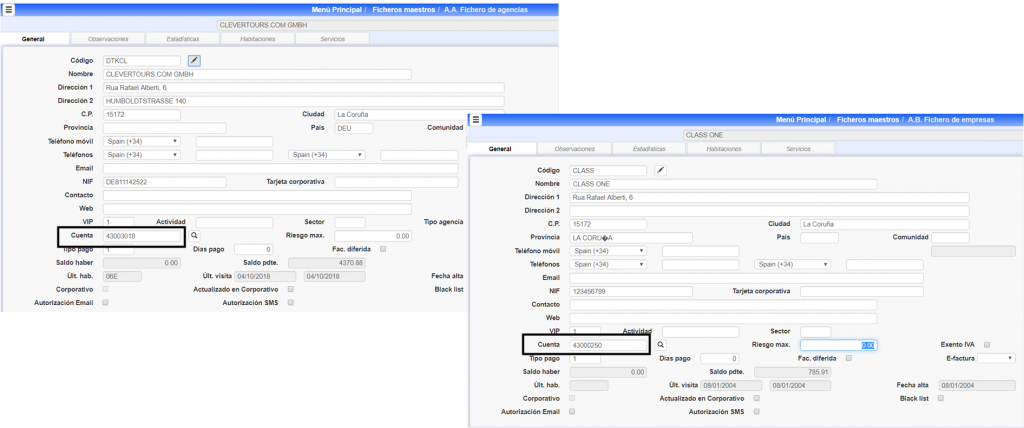
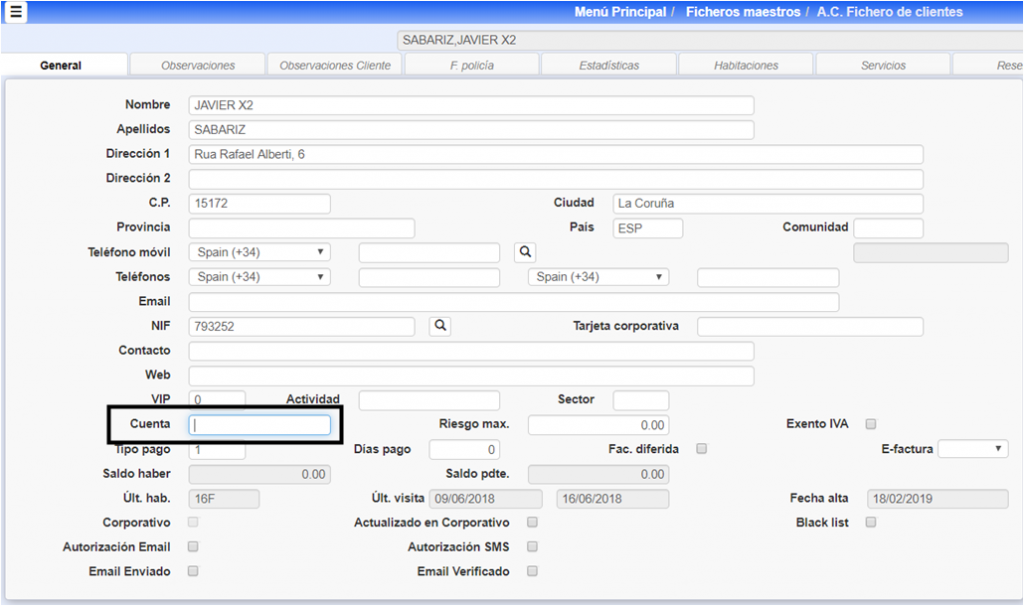
Si está sin valor toma la que existe en la opción B.7. por defecto
Invoices Entry
2). OUTPUT VAT ACCOUNTS:
It is in the option (.B.7.) Control Records, Taxes. V.A.T. Accounts
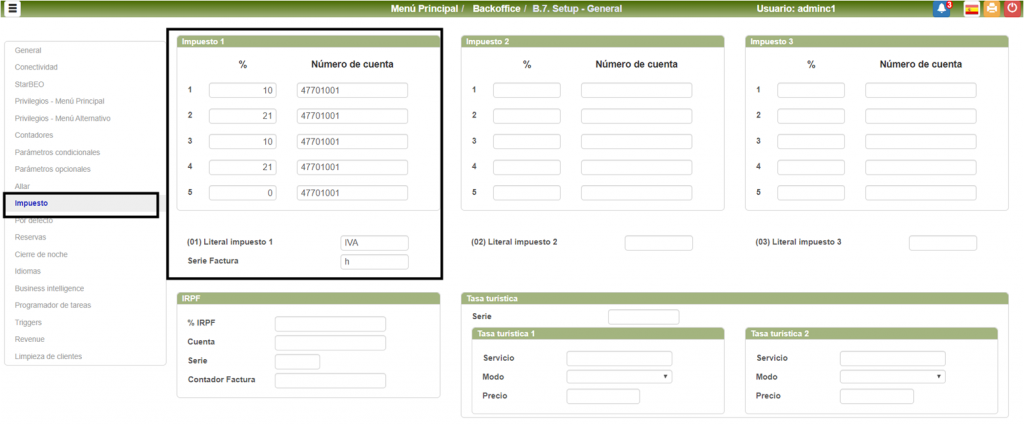
Invoices Entry
3). SALES ACCOUNT:
In the case of the example there is ONLY ONE SALES ACCOUNT which is the one corresponding to the ROOM. (.A.2.).

Invoices Entry
Other more complex Entries in the Hotel Invoicing
It will basically depend on the SALES accounts, so we will list some of the possibilities we have to invoice a client. Before, it is recommended that we give the default values in the Control Records, so that the creation of a new registration AT LEAST ASSUMES A LOGICAL VALUE.
They are : – Rooms. – Regime. – Services. In (.B.7.)

Invoices Entry
SECTIONS THAT HAVE SALES ACCOUNTING ACCOUNTS: .A. (.2.//.3.//.4.//.6.//.7.//.8.)
Besides the own SALES, we can make some DISCOUNT %, (the ACCOUNTING ACCOUNT will be the one that is in the section .11. of the Registers of Control. In (.B.7.)

Let’s see an example of a MULTIPLE SALE, with discount
Warning:
When the accounting mode is by PRODUCTION, read the first section of this CHAPTER, the form of ACCOUNTING for these invoices is not the same, since the GROUP ACCOUNTS .7. are already ACCOUNTED BY PRODUCTION, being against PRODUCED CUSTOMERS and NOT INVOICED in the CUSTOMER ACCOUNT and in THIS FORM is compensated. It is recommended that if this procedure is used, do not give a 43rd account, since then it should not be included in duplicate in model 437 (CUSTOMERS SALES MORE than 500,000), use any other auxiliary.
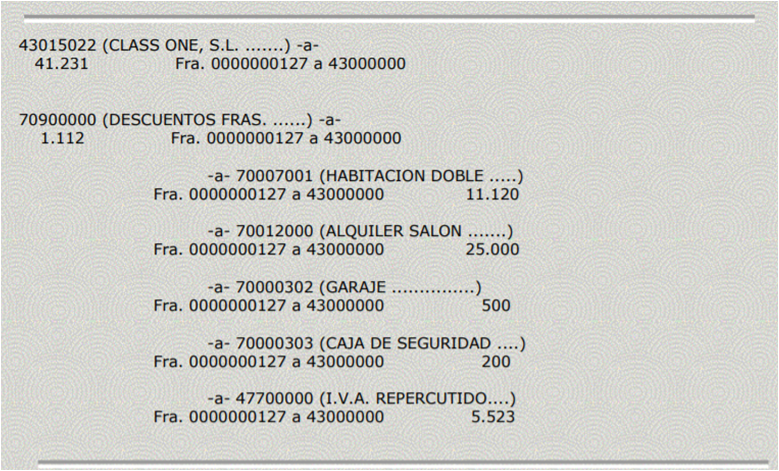
ej. anterior rectificado.
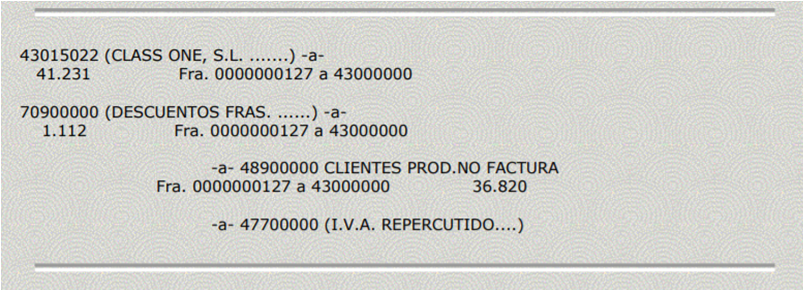
Collections Entry
Hemos realizado la VENTA, ahora debemos realizar el cobro. Estudiemos las posibilidades:
- Realizamos un COBRO normal por más de una FORMA de PAGO.
- Se realiza un COBRO de un ANTICIPO.
- En el COBRO ANTERIOR a) en la FORMA de PAGO TARJETA de CREDITO, nos dejan incluida la PROPINA, y además ya había pagado una parte mediante un ANTICIPO.
ANALICEMOS LAS FORMAS DE PAGO. APARTADO .A.D..
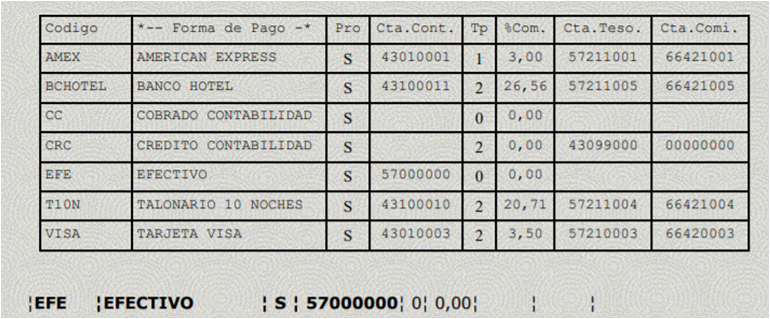
Cobro en EFECTIVO. La cuenta de CAJA de RECEPCION es por tanto la 57000000.
Este es el caso más normal. La VENTA ya la hemos explicado anteriormente pero para mayor claridad repetimos un ejemplo.

Veamos ahora un caso muy especial que además CUBRE TOTALMENTE todas las posibilidades de las TARJETAS de CREDITO (T.C.). Es el caso de los FAMOSOS TALONARIOS 10 NOCHES, O BANCOHOTEL.
¦T10N ¦TALONARIO 10 NOCHES ¦ S ¦ 43100010¦ 1¦20,71¦ 57211004¦ 66421004¦
Cobro de CREDITO. El CREDITO es 43100010 correspondiente a ADHOMESA GRUPO SOL. TIPO “1” CREDITO PRACTICAMENTE DISPONIBLE. Vemos que además nos cobran una comisión del 20,71 %, consideramos que del COBRO TOTAL un 20,71% va a la cuenta 66421004. En este caso los TALONARIOS que los CLIENTES nos dan los CONSIDERAMOS como si fuese DINERO que lo ingresamos en la CUENTA 57211004 (Cuenta de TESORERIA). Veamos este caso en REAL:
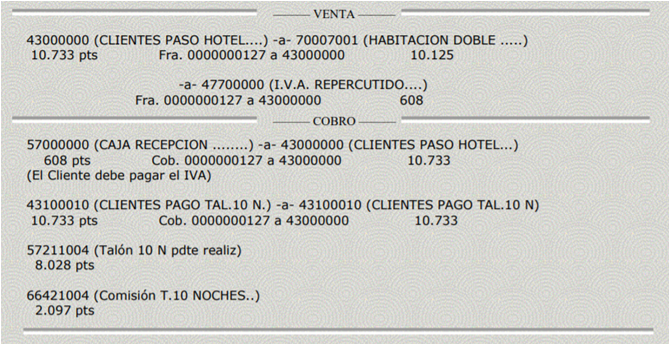
Expliquemos el caso anterior de una manera más legible.
1). Cada TALON “VALE” 3.375, de las cuales nos cobran de comisión 699. Esto equivale a que por cada talón nos cobran una COMISION del 20,71 % (3.375 * 20,71% = 699), evidentemente al margen de en lo que podamos evaluar los intereses técnicos del tiempo que NOS TARDAN EN PAGAR dichos talones 10 NOCHES.
2). Como realizaríamos este caso en SEVEN STARS:
2.1. Se crea una tarifa ESPECIAL T10N, en la cual se especifica cuanto vale cada habitación en valor de dichos TALONES.
2.2. Se creará una FORMA de PAGO especial para realizar dicho COBRO, T10N.
Se considera CREDITO clave “1”, con COMISION 20,71 % y se aconseja crear una cuenta CONTABLE de tipo TESORERIA (572), ya que se supone que los “papelitos/talones” es “dinero”. Además damos una cuenta para que nos refleje la COMISION calculada por el programa (6624 ó 626)
A la hora del COBRO, diremos que el CLIENTE paga 10.125 en TALONARIOS 10 NOCHES (3 TALONES) y 608 (el I.V.A.) en cash, T.C., etc que es el I.V.A. que debe pagar el CLIENTE.
Para efectos de administración, evidentemente nos quedaría por realizar el apunte del cobro real a la cuenta responsable de los talonarios 10 NOCHES. Cuando nos llegue la liquidación de los talonarios enviados, se descargará la liquidación de la cuenta que hemos asignado a TESORERIA 10 NOCHES (Este es un criterio ya que es indiferente que se considere un CLIENTE PENDIENTE de PAGO p.ej. 431.xx.xxx), por las cantidades que nos han abonado, introduciendo dicho importe/talón/cheque, en el Banco o CUENTA CONTABLE que le corresponda. Se cuadrará a su vez la CUENTA de COMISIONES si es que existiesen problemas de descuadre (pesetillas de redondeos), que además nos vale de cálculo y control de dichas comisiones, al igual que imputaremos el I.V.A. de la factura de comisiones que nos envíen.
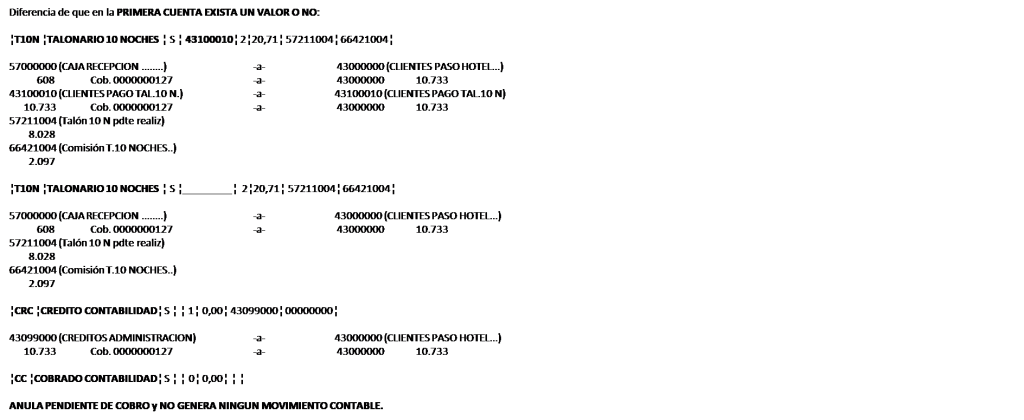
Asiento de Anticipos y Depósitos.
Por qué diferenciamos Anticipos de Depósitos?
Anticipos.
Consideramos el concepto de Anticipo como una cantidad a cuenta que en general se aplicará posteriormente al pago de una factura.
Se guarda un histórico de todos los anticipos al igual que de su aplicación.
El apunte contable que se genera contra la cuenta de ANTICIPOS, es los TRES PRIMEROS CARACTERES DE LA CUENTA DE CONTROL más los 5 ULTIMOS NUMEROS DE LA CUENTA DEL CLIENTE AL QUE SE LE APLICA EL ANTICIPO.
Depósitos.
Se considera depósito aquellos importes que el cliente nos deja en prenda, por el préstamo de un determinado servicio (toallas, mando TV, Llave Caja Fuerte, …), y posteriormente se le devuelve dicho importe al acabar el servicio.
No se almacena su histórico, muere en el momento en el que se le hace la devolución al cliente.
Observamos que todas las cuentas 438, los cinco dígitos a continuación son diferentes:
Por ejemplo la primera cuenta 43832004
se corresponde al cliente
43032004
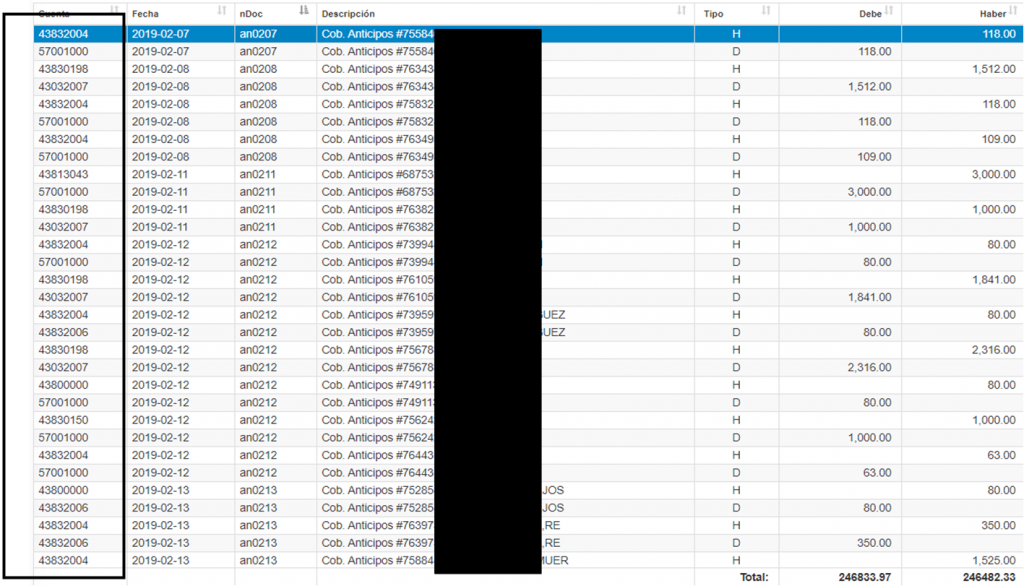
Cuando realizamos un COBRO de un ANTICIPO, el DEBE quedará determinado por la FORMA de PAGO y el HABER es la CUENTA de ANTICIPO (Registros de Control apartado (.B.7.09.)). Ver nota anterior

COBRO ANTICIPO
57000000 (CAJA RECEPCION ……..) -a- 43700000 (CLIENTES FRAS.PDTES F.)
10.000 Cob. Anticipos -a – 43015022 10.000
c). En el COBRO ANTERIOR a) en la FORMA de PAGO TARJETA de CREDITO, nos dejan incluida la PROPINA, y además ya había pagado una parte mediante un ANTICIPO.
Poseemos una cuenta en la cuál se imputarán las PROPINAS, fundamentalmente es para el control de aquellas propinas que se incorporan en los cierres de las tarjetas de crédito, aunque no es restringido a que se quiera controlar propinas en CASH. Se puede abrir como una cuenta 46500, que es de remuneraciones pendientes de pago, de tal forma que contabilidad cuando desee, hará la imputación a la sección/empleado/… de dicho acumulado de propinas, descontando o nó los porcentajes que cobran de comisión las tarjetas de crédito.
46 – PERSONAL 465 – REMUNERACIONES PENDIENTES DE PAGO 46500 – REMUNERACIONES PENDIENTES DE PAGO 46500000 – REMUNERACIONES PENDIENTES DE PAGO
Asiento Propina.
46 – PERSONAL 465 – REMUNERACIONES PENDIENTES DE PAGO 46500 – REMUNERACIONES PENDIENTES DE PAGO 46500000 – REMUNERACIONES PENDIENTES DE PAGO
La CUENTA de PROPINAS, SEVEN STARS la asume de Registros de Control apartado (.B.7.11.)).

Veamos el caso de la VENTA que hemos explicado, CLASS ONE, S.L. nos debe 41.231, MENOS un ANTICIPO de 10.000. Por ello le quedan por pagar 31.231 y nos dice que le cobremos por VISA pero como le han atendido muy bien que le COBREN 33.000
¦VISA ¦TARJETA VISA ¦ S ¦ 43010003¦ 2¦ 3 50¦ 57210003¦ 66420003¦
Al dar el PAGO de la FACTURA, el ANTICIPO ya lo asume automáticamente, y se le dice que en vez de 31.231 el CLIENTE ABONA 33.000. Veamos que ASIENTO CONTABLE GENERA:
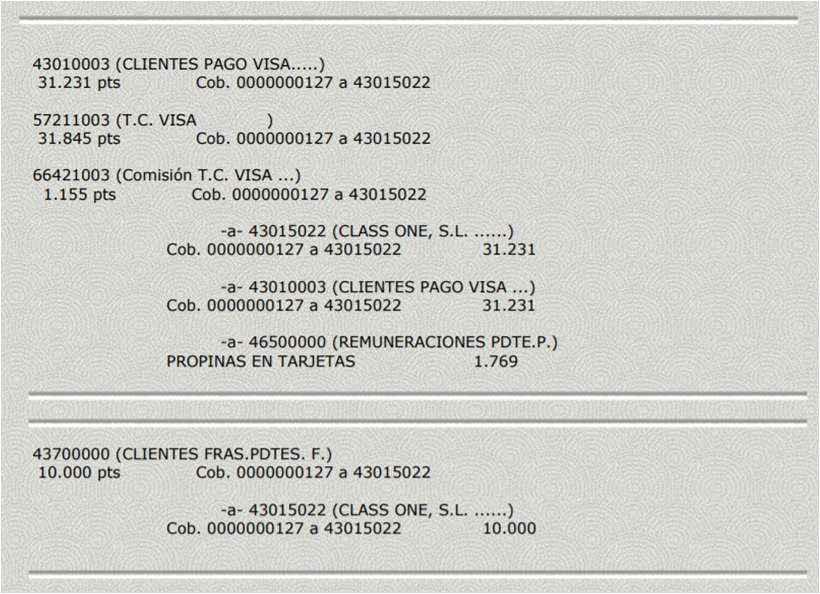
Sistema Contable ANALITICO-DEPARTAMENTAL (XYZ).
? QUE ES LO QUE SE ENTIENDE POR SISTEMA XYZ ?
En realidad es conseguir una MODELIZACION CONTABLE ANALITICO-DEPARTAMENTAL, sin ampliar sino más bien simplificar el P.G.C. (Plan General Contable), y obtener en, digamos otros planos diferentes los datos ANALITICO-DEPARTAMENTALES.
En el caso de HOTELES, vía la CONTABILIDAD se pueden conseguir además de los informes clásico-financieros de la CONTABILIDAD TRADICIONAL, la CONTABILIDAD ANALITICA, similar y si cabe decirlo más potente todavía, que lo que los americanos han dado en llamar “A UNIFORM SYSTEM OF ACCOUNTS FOR HOTELS” cuya primera edición ha sido publicada en 1.926 por la Asociación de Hoteles de la ciudad de New York.
Actualmente se usa más el concepto USALI (Uniform System of Account for Lodging Industry)
Para ello debemos de tener MUY CLAROS LOS TRES CONCEPTOS SIGUIENTES:
XXX TIPO de INGRESO o GASTO (también llamado ACTIVIDAD)
XXX DEPARTAMENTOS
XX CENTRO de COSTE / HOTEL / RESTAURANTE/ …
Por ello digamos que dentro de la CONTABILIDAD existe por un lado la CUENTA CONTABLE tradicional del P.G.C., y además otra CUENTA ANALITICA ASOCIADA a cada movimiento “ANALITICO”, formada por:
- xxx. Tipo de INGRESO / GASTO.
- xxx. Departamento ANALITICO.
- xx. Centro de Coste u Hotel.
1). TIPOLOGÍA del Movimiento. TIPO de INGRESO o de GASTO.
Significa que debemos de tipificar los movimientos analíticos, mejor llamado ACTIVIDAD en Contabilidad Americana. Veamos dónde y por que.
Concepto sólo INGRESO.
En aquellos conceptos que ya se sabe son exclusivamente de ingresos, se deberá dar un código numérico de 3 posiciones, en nuestro caso afecta a : HABITACIONES, SALONES, REGIMENES, y SERVICIOS.
(01). HABITACIONES y/o SALONES. Vemos que en el campo .7. figura tipo de ingreso 071 y como departamento de HABITACIONES y/o SALONES el 071.
(01). HABITACIONES y/o SALONES. Vemos que en el campo .7. figura tipo de ingreso 071 y como departamento de HABITACIONES y/o SALONES el 071.
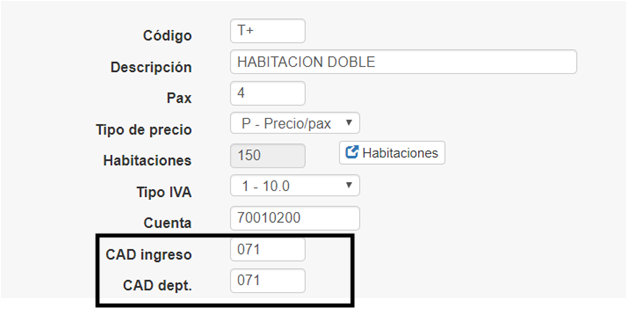
(02). REGIMENES. En este ejemplo figura como tipo de ingreso el 091 y como DEPARTAMENTO de DESAYUNO CONTRATADO el 091.
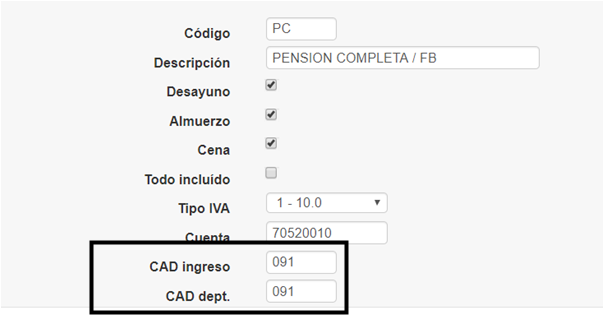
(03). SERVICIOS. Hemos sacado la pantalla de visualización ya que es más explicita, como vemos por ejemplo BAR, le hemos puesto TIPO de INGRESO “701” y DEPARTAMENTO ANALITICO ASOCIADO el “001”, a GARAJE, “704” y “004”, etc

(04). PAQUETES.
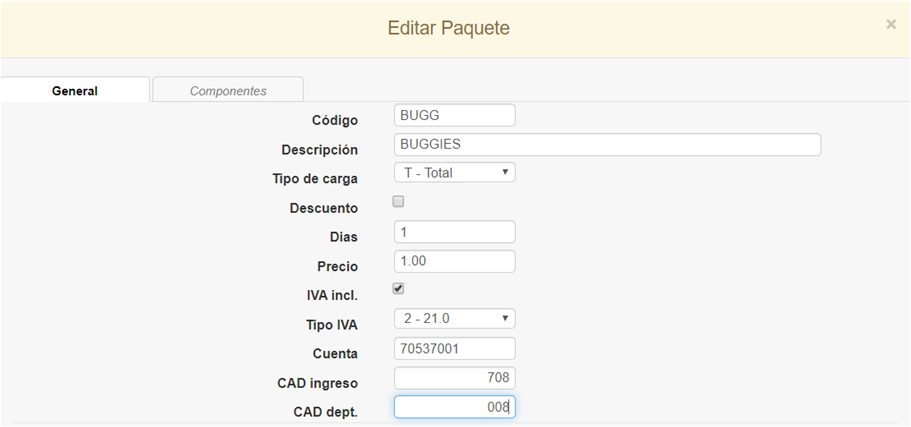
Habrá que dar los dos tipos para cuando sean conceptualmente de INGRESO o de GASTO, en nuestro caso afecta a:
FAMILIAS de PRODUCTOS. Ya que los productos se pueden vender y/o Consumir.
VER EXPLICACION StarsEcon.
2). DEPARTAMENTO ANALITICO.
Debemos de indicar el DEPARTAMENTO ANALITICO al cuál corresponde dicho movimiento. Como ya hemos visto anteriormente en los conceptos de VENTA de: HABITACIONES/SALONES/REGIMENES y SERVICIOS, además del TIPO de INGRESO se debe dar también el DEPARTAMENTO ANALITICO asociado a dicho INGRESO:
(01). HABITACIONES y/o SALONES. Vemos que en el campo .7. figura tipo de ingreso 071 y como departamento de HABITACIONES y/o SALONES el 071.

(02). REGIMENES. En este ejemplo figura como tipo de ingreso el 091 y como DEPARTAMENTO de DESAYUNO CONTRATADO el 091.

...
Además de estos movimientos típicos de ingreso que los catalogaríamos como ASOCIADOS A FRONT-OFFICE, existen otros movimientos ANALITICO-CONTABLES, que van asociados directamente a UN DEPARTAMENTO, este es el caso de las ventas por T.P.V.’s, las existencias en los diferentes ALMACENES/DEPARTAMENTOS, los CONSUMOS de cada DEPARTAMENTO, las PERDIDAS/ MERMAS/REAJUSTES de cada ALMACEN-DEPARTAMENTO, el COSTE de la VENTA de cada ALMACENDEPARTAMENTO, etc.
VER EXPLICACION StarsEcon.
3). CENTRO de COSTE (HOTEL / RESTAURACIÓN).
Es el CENTRO de COSTE/PRODUCCION que origina el movimiento, evidentemente tiene validez cuando hablemos de CADENAS HOTELERAS o bien de HOTEL y/o RESTAURANTE, etc.
En todos los ejemplo que veamos hemos puesto como código del HOTEL el “001″. Dicho DATO habrá que dárselo en los REGISTROS de CONTROL. (opción .B.7.)
Para Allar, se toman exclusivamente los dos últimos dígitos en este caso 01.

Código del Hotel. Código analítico del Hotel, se corresponde con el Centro de Coste del Hotel para los estudios analíticos (sistema XYZ).
Se toman los “2” dos, últimos caracteres.
RESUMEN FUNCIONAL de XYZ.
Es evidente que si tenemos las ventas por DEPARTAMENTO, evidentemente DEPARTAMENTOS ANALITICOS, las EXISTENCIAS, los CONSUMOS, las PERDIDAS, los REAJUSTES de INVENTARIO, y los COSTES de LA VENTA, “casi” podríamos saber a la perfección la RENTABILIDAD real por DEPARTAMENTO.
Que nos falta, a grandes rasgos, es evidente que los COSTES de PERSONAL, y OTROS COSTES FINANCIEROS, está claro que para aquellos que conocen ALLAR, no es ningún problema la introducción de dichos datos.
Vemos entonces que hablar de “A UNIFORM SYSTEM OF ACCOUNT FOR HOTELS”, (USALI) no digo que sea una tontería pero si digo que es muy fácil, y además que sistema nos puede ofrecer más visiones que ALLAR, en su apartado XYZ.

